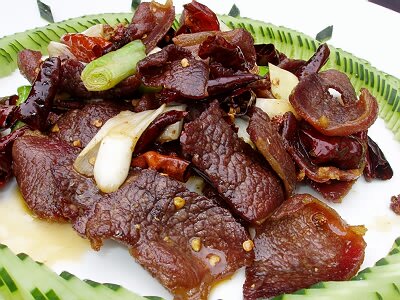 |
| (file photo) |
Jerky in Yunnan can be divided into three types: Hui jerky, Zang jerky and Dai jerky. Each of them has its own features and ways of eating.
Hui People have had the eating habit of dry salting beef jerky since ancient times. The ox, which will be used to make beef jerky, first should be raised for half a year so that it can be strong enough. Normally, the slaughter procedure is conducted in the mornings of October and December (lunar calendar) and it brings festival mood to the village. Skilled butchers cut the ox into 24 parts and hang them on the walls or eaves to make them dry, and then salt them in the evening. After having been salted for 15 to 20 days, beefs are taken out from the jar and will be given a thorough airing. It takes another 15 days. When the airing procedure is done, the jerky is ready to eat.
Tibetan cut the beef into lumps and then add salt and peeper into it to make beef jerky. It is extreme cold in the northwest part of Tibetan areas, so jerky can be made at all seasons.
In contrast, since it is hot all year round in Dai area, Dai people slice the beef so it is easy to dry. They also have the custom of salting sour beef.
The way of eating varies from areas to areas as well. Hui people are used to fry or sauté beef jerky while Dai people usually roast the jerky with burning coals, chop it with wood sticks, tear it into strips and then fry it or eat it directly with seasoning. Zang people cut the jerky into slices and fry them to make them crispy and spicy.
 National Plug In Day celebrated in Washington D.C.
National Plug In Day celebrated in Washington D.C. New model of indigenous surface-to-air missiles testfired
New model of indigenous surface-to-air missiles testfired  118.28-carat diamond to be auctioned in HK
118.28-carat diamond to be auctioned in HK Maternal love under streetlight
Maternal love under streetlight Naked foreign student sits in the middle of a road in Haikou
Naked foreign student sits in the middle of a road in Haikou  Colorful Yunnan: Enjoy the natural beauty
Colorful Yunnan: Enjoy the natural beauty Harbin named Chinese city with most beautiful women
Harbin named Chinese city with most beautiful women For last four students, teacher couple sticks to post on island
For last four students, teacher couple sticks to post on island  When big sport stars were kids
When big sport stars were kids PLA's 38th Group Army conduct training
PLA's 38th Group Army conduct training People mourn for victims of mall attack
People mourn for victims of mall attack The last days of Wan Aihua
The last days of Wan Aihua Highlights at 12th National Games of China
Highlights at 12th National Games of China Beijing Film Academy welcomes freshmen
Beijing Film Academy welcomes freshmen Large mahjong party sets new world record
Large mahjong party sets new world recordDay|Week|Month